How to glue the ceiling plinth
The modern market of building and finishing materials represents a huge range of baseboards for various surfaces. The choice of these finishing elements is so great that it is able to satisfy the most demanding customers. These are wooden, polyurethane, plastic plinths, and also products from polyfoam and polystyrene. There are special plinths for the floor and for the ceiling. But people often do not know what kind of glue to glue the ceiling plinth, because for each material and type of surface a special composition is needed. There is no unequivocal answer to this question, so let's try to figure out what characteristics the best glue for ceiling moldings should have.
Polymer formulations
The most popular when attaching ceiling moldings are polymeric compositions that have an excellent binding base, short drying time and excellent adhesion quality of the finishing material to the base. The most common brands among them are Titan and Moment.
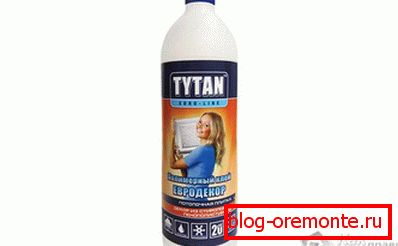
Titanium is an adhesive solution, which is based on polymeric compounds, it is suitable for baseboards made of different materials. Advantages of glue are:
- wide range of applications, suitable for interior and exterior use;
- resistance to temperature extremes;
- moisture resistance;
- low consumption of the composition;
- instant adhesion and drying;
- base viscosity;
- composition elasticity;
- affordable price.
Clay Moment is no less in demand on the Russian market.
The main disadvantages of the moment are: high cost and very fast drying time. When working with the Moment, a very high precision of the application of the composition is required, and not only because of the rapid solidification, but also because it can damage the face of the product by hitting it. If the glue is still on the surface, it should be quickly removed with a dry cloth. When gluing the plinth to the ceiling using a polymer composition, the part to be attached should be pressed against the surface joint until the glue dries to avoid shearing. The room in which the repair work is carried out should be aired.
There are many brands of adhesives, which differ in manufacturer and cost. By purchasing a polymer composition, you can immediately buy a solvent that will not allow the glue to dry prematurely.
Liquid Nails

If the material for the manufacture of ceiling moldings is wood, then it is best to keep the liquid nails. Sometimes you have to use screws to strengthen the fasteners. Liquid nails tightly and securely fix the ceiling plinth no matter what material is the basis of their manufacture. In the hardware store you can find two types of liquid nails: acrylic and neopropylene. Please be aware that neopropylene nails are based on organic solvents. The composition has a very pungent smell, which may be unsafe for humans. They need to work in respirators in a ventilated room. The main advantage of nails is that they do not lose their properties in conditions of high humidity.
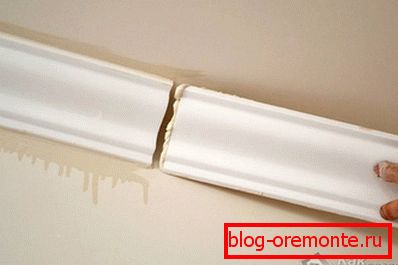
Acrylic nails, which are not suitable for wet rooms, do not have a strong odor, and are considered to be an environmentally friendly compound, safe for people. Made on the basis of water, acrylic liquid nails are used for fastening plinths made of various materials. Their disadvantage are:
- low adhesive properties:
- long period of drying and bonding;
- sensitivity to temperature changes.
In rooms where the humidity indicators exceed the permissible rate, silicone-based glue is used. Decor elements made of plaster, experts recommend to glue on a mixture of gypsum with a primer with the addition of PVA. Such a composition can be made independently. But massive stucco needs additional fasteners in the form of screws or dowels.
Glue acrylic putty
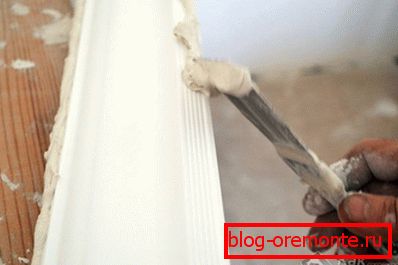
Using a special putty will not align the wall before pasting it with plinths. Surface defects, bumps and gouges can be hidden under a layer of the same adhesive mixture. Another advantage of the composition is that the plinth does not have to press for a long time to the joint. Putty can work in enclosed spaces, because it does not emit harmful substances when dried. The indisputable advantages of the composition are also:
- strength and reliability of fastening;
- simplicity and ease of use;
- coating uniformity;
- affordable price;
- the mixture can be made independently.
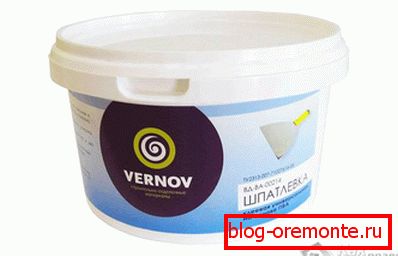
Acrylic putty is used for fixing to the ceiling baseboards made of polystyrene and foam, which melt from glue, prepared with the addition of solvents.
Fastening the plinth with a putty is done before the finishing of the room, that is, before pasting with wallpaper, painting the walls. Acrylic composition is distributed evenly over the surface area where the plinth will be located.
Then the plinth is applied and fixed, the excess mixture is removed with a rubber spatula or a sponge slightly moistened with water.
Preparation of adhesive acrylic composition
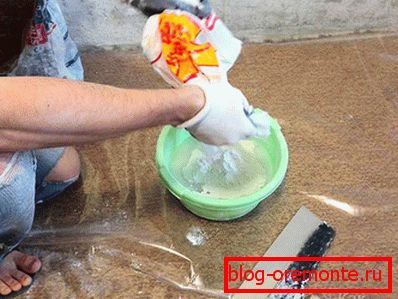
It is not worth spending money on the purchase of adhesive putty. The mixture can be made independently from the following materials:
- dry finishing putty;
- PVA;
- water;
- mixing tank.
It is not necessary to look for a special dry finish mixture, any one that is handy will do. It should be poured into the prepared container and add the PVA. The following proportions should be observed: 4 parts of the mixture to 1 part of the PVA. Then mix everything thoroughly, adding water. Mixing is performed until a homogeneous thick suspension. Now let the resulting mixture stand for 4–6 minutes, and mix everything well again, making sure that there are no lumps and clots in the mixture. Ready putty must be used for its intended purpose within an hour.
Video
More information on the use of liquid nails and glue putty below: